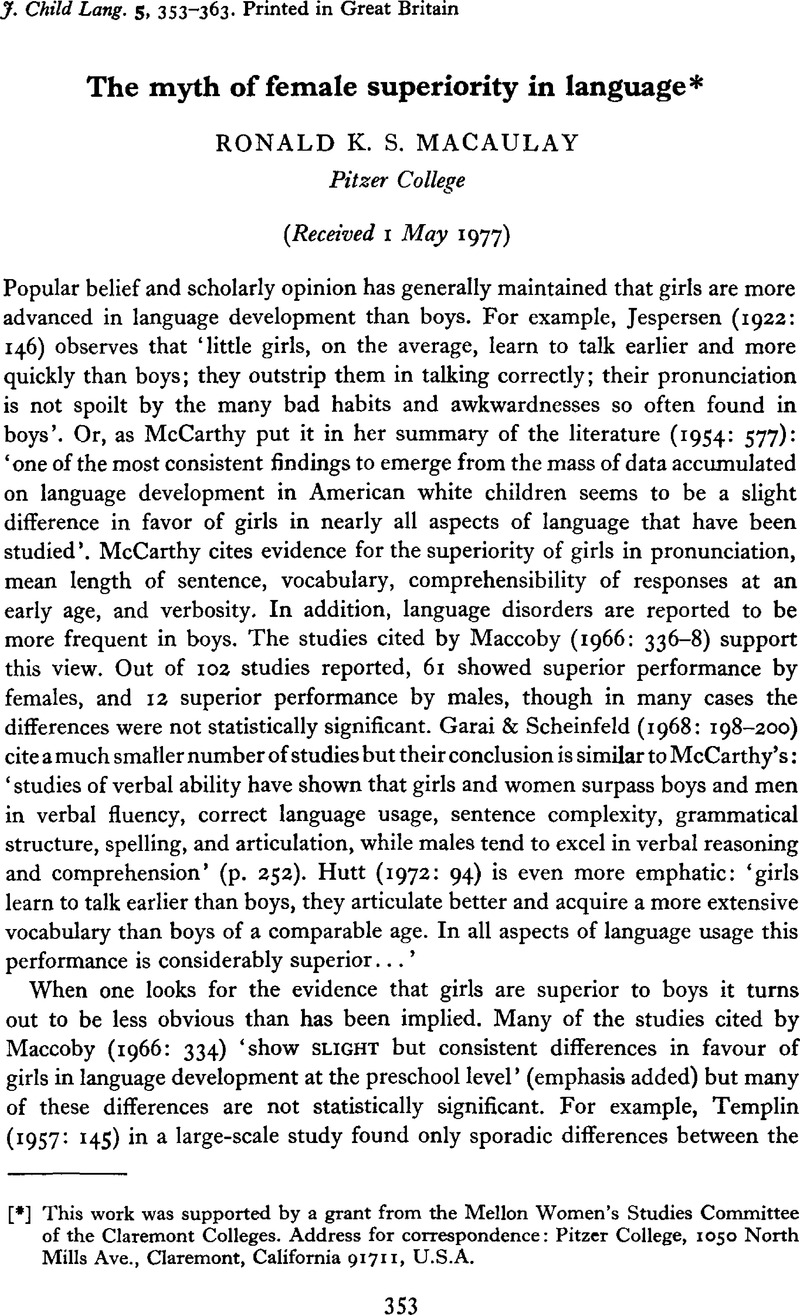Crossref Citations
This article has been cited by the following publications. This list is generated based on data provided by Crossref.
Dalby, J. Thomas
1979.
Deficit or Delay: Neuropsychological Models of Developmental Dyslexia.
The Journal of Special Education,
Vol. 13,
Issue. 3,
p.
239.
Ekstrand, Lars Henric
1980.
Sex differences in second language learning? Empirical studies and a discussion of related findings.
Applied Psychology,
Vol. 29,
Issue. 1-2,
p.
205.
Horgan, Dianne
1981.
Rate of language acquisition and noun emphasis.
Journal of Psycholinguistic Research,
Vol. 10,
Issue. 6,
p.
629.
Klann-Delius, Gisela
1981.
Sex and language acquisition - Is there any influence?.
Journal of Pragmatics,
Vol. 5,
Issue. 1,
p.
1.
Slobin, Dan I.
and
Bever, Thomas G.
1982.
Children use canonical sentence schemas: A crosslinguistic study of word order and inflections.
Cognition,
Vol. 12,
Issue. 3,
p.
229.
Sigelman, Carol K.
Elias-Burger, Susan F.
Danker-Brown, Pamela
and
Burger, Donald L.
1982.
Are sex differences in nonverbal and verbal behavior generalizable to mentally retarded persons?.
Journal of Nonverbal Behavior,
Vol. 6,
Issue. 4,
p.
259.
Staley, Constance M.
1982.
Sex-related differences in the style of children's language.
Journal of Psycholinguistic Research,
Vol. 11,
Issue. 2,
p.
141.
Bennett-Kastor, Tina L.
1986.
The two fields of child language research.
First Language,
Vol. 6,
Issue. 18,
p.
161.
Wolf, Maryanne
and
Gow, David
1986.
A longitudinal investigation of gender differences in language and reading development.
First Language,
Vol. 6,
Issue. 17,
p.
81.
EDELSKY, CAROLE
SEARFOSS, LYNDON W.
and
MERSEREAU, YVONNE M.
1986.
Variation and Authenticity in a Study of Children's Written Humor.
Written Communication,
Vol. 3,
Issue. 3,
p.
344.
Reznick, J. Steven
1990.
Visual preference as a test of infant word comprehension.
Applied Psycholinguistics,
Vol. 11,
Issue. 2,
p.
145.
Mulac, Anthony
Studley, Lisa B.
and
Blau, Sheridan
1990.
The gender-linked language effect in primary and secondary students' impromptu essays.
Sex Roles,
Vol. 23,
Issue. 9-10,
p.
439.
Craig, Holly K.
and
Evans, Julia L.
1991.
Turn Exchange Behaviors of Children With Normally Developing Language.
Journal of Speech, Language, and Hearing Research,
Vol. 34,
Issue. 4,
p.
866.
Holmes, Janet
1991.
Language and gender.
Language Teaching,
Vol. 24,
Issue. 4,
p.
207.
Corson, David J.
1992.
Language, Gender and Education: a critical review linking social justice and power.
Gender and Education,
Vol. 4,
Issue. 3,
p.
229.
Macaulay, Ronald K. S.
1993.
Elaine Slossberg Andersen, Speaking with style: The sociolinguistic skills of children. London & New York: Routledge, 1992. Pp. 200. $10.95. [Paperback reprint of 1990 publication.].
Language in Society,
Vol. 22,
Issue. 3,
p.
442.
Camaioni, Luigia
and
Longobardi, Emiddia
1995.
Nature and stability of individual differences in early lexical development of Italian-speaking children.
First Language,
Vol. 15,
Issue. 44,
p.
203.
Langenmayr, Arnold
and
Schmitz, Harald
1996.
Learning Test on Expressive Phonetic Symbolism.
Perceptual and Motor Skills,
Vol. 83,
Issue. 1,
p.
227.
1997.
REFERENCES.
Monographs of the Society for Research in Child Development,
Vol. 62,
Issue. 1,
p.
142.
Washington, Julie A.
and
Craig, Holly K.
1998.
Socioeconomic Status and Gender Influences on Children's Dialectal Variations.
Journal of Speech, Language, and Hearing Research,
Vol. 41,
Issue. 3,
p.
618.



